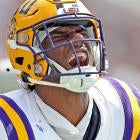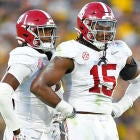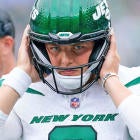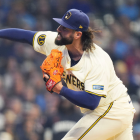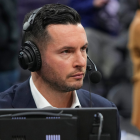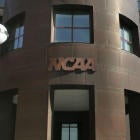BIRMINGHAM, Ala. -- The engineer who helped revolutionize safety in auto racing plans to begin player testing of a new football helmet that he predicts will significantly reduce concussions.
Dr. Dean Sicking, a professor at the University of Alabama at Birmingham’s School of Engineering, said the helmet is designed to reduce concussions by 75 percent, and he hopes for a 50-percent cut once testing begins in October. He also envisions a larger goal: Change how football helmets are tested by using crash-test dummies on a sled.
“Much of the football helmet industry sticks to the mantra, ‘We can’t prevent concussions’ and that’s where they stop,” Sicking said. “They try to improve themselves on arcane procedures that are designed to prevent skull fractures but doesn’t do anything to prevent concussions.”
Sicking is part of a competitive industry with designers trying to make safer football helmets and become the one to handsomely profit from it. Many medical experts believe there is no concussion-free helmet, and Sicking acknowledges his first model has a weakness because it doesn’t address rotational forces for the neck upon impact.
What’s unique about Sicking is where he comes from: the auto safety world of national highways, NASCAR and Indy Racing League. After the death of race car legend Dale Earnhardt in 2001, Sicking developed the SAFER (Steel And Foam Energy Reduction) barrier, a collapsible wall used by major speedways in auto racing. Since SAFER was created, no fatalities and only one serious injury have occurred at those speedways, Sicking said.
“The same thing can be done with helmets if we’re willing to look at a system and apply all available technologies,” Sicking explained at a recent concussion summit in Birmingham sponsored by the Wise Up Initiative and Children’s of Alabama.
Dr. Robert Cantu, a pioneer in treating sports concussions, attended the summit and praised Sicking for “thinking totally outside the box by changing the outer portion of the helmet.” SEC officiating coordinator Steve Shaw was present as well and, after hearing the presentation, told Sicking, “We’ve got to get these helmets to everybody and not have a high school worry, ‘What if I break three face masks? I can’t afford that technology.’”
A die-hard Dallas Cowboys fan, Sicking took on concussions after 35 years of car safety. At one point, almost every new guardrail terminal installed on the National Highway System was covered by one or more of Sicking’s patents that he estimates saves 1,000 lives per year.
Sicking spent two decades at the University of Nebraska and was recruited heavily by UAB in 2012. He even met with Barber Motorsports Park owner George Barber, who offered Sicking his own space at the racetrack to conduct safety research.
“The car design people don’t venture out of their cubbyholes because they’re tied with golden chains -- they’re paid so much, they can’t afford to go and quit and do something else,” Sicking said. “I’m an academic and was, quite frankly, burned out and kind of achieved all the goals I had set in highways.
“I wrote the standards for our industry twice. Once I wrote it the second time, work started flowing into the door. I didn’t have to do anything. I’m sitting on my fingers getting bored. I lost my fire in my belly. I needed a new challenge.”
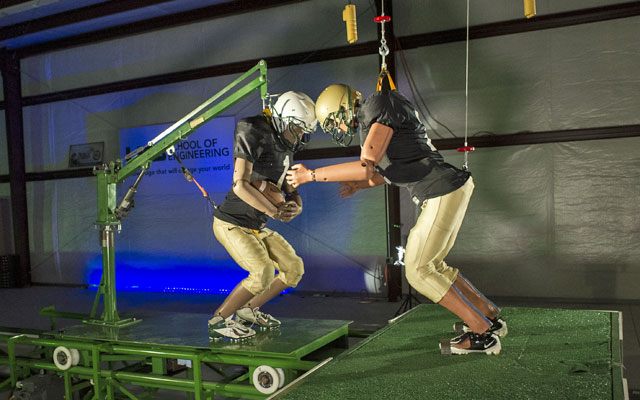
Recreating football crashes
There are no end-all, be-all cures for football helmet safety. That doesn’t stop inventors from testing and selling theories. Since 2011, Virginia Tech biomedical engineering professor Stefan Duma has released safety ratings of helmets designed to reduce the risk of concussions.
Last year’s release of the SpeedFlex football helmet by Riddell was “a big departure in shell technology,” Duma said. “No one has done that before to have a flexible aspect to it.” Multiple teams, including Arkansas, wore the SpeedFlex helmet last year.
In the past four years, 11 new helmets have been given Duma’s highest five-star rating. More helmets keep coming down the pipe.
“You can hardly spit in academia without hitting someone designing a helmet,” Sicking said. “But what they don’t have are people who have been working in impact their whole lifetime.”
Creating a safer wall and a safer helmet are much different, but the same principle is being applied. Sicking wants a helmet -- just like a barrier -- that will absorb as much energy as possible upon impact. Sicking replaced the polycarbonate shell on the outside with material that absorbs more energy.
For competitive purposes, Sicking won’t disclose yet what material he is using. He said the new material will absorb about three times more energy than polycarbonate.
“They’d all catch up real fast if I told you what we’re using,” Sicking said. “Right now, I think we have about six months to a year lead on others.”
The chinstraps and face masks are intended to have more flexibility so the helmet can move without the head moving. Many severe concussions occur due to significant rotational acceleration of the head.
“I’m sure a lot of people in football won’t like this idea because the face mask is going to get bent and have to be replaced,” Sicking said. “But if you have a concussive-level impact, would you rather bend the face mask or have a player be out several weeks? We need to be willing to accept these technologies that will have a huge impact in safety, albeit with some costs to replace a face mask on two or three players a game.”
Sicking said the material cost for his helmet will be less than other materials, but his helmets will be slower to produce and result in a “moderate” increase for consumers. Helmets generally sell for a couple hundred dollars with most of the costs due to insurance.
As he did with highways and auto racing, Sicking is trying to recreate the crash in football. He believes sensors in helmets provide a lot of good information from collisions, but not enough key information.
So just like with racing, Sicking’s team members analyze video. They reviewed film from Alabama football games to identify what they believe are the 400 worst head impacts. The software analyzes player closing speeds, impact points on the helmets, player masses and body orientations to record the conditions before, during and after each collision.
Sicking believes helmets should be designed by position. For example, he said offensive linemen who take 40 to 50 hits per game at lower speeds shouldn’t be wearing the same high-energy helmet as a wide receiver who gets blown up by a defensive back.
“If we can predict the destruction of a race car with this precision, we certainly can do it with the helmet,” Sicking said. “Helmet technology is not nearly as difficult as the race car.”
Changing testing standards
There’s a bigger vision than helmets in play for Sicking. He wants to change how helmets are tested. Typically, helmets are examined with the drop test, which lifts a helmet six feet into the air and drops it onto a rubber-coated concrete and steel block.
The National Operating Committee on Standards for Athletic Equipment (NOCSAE) recently instituted a rotational test for helmets as well. The helmets test out better but are nowhere near where they need to be to stop a concussion, said Cantu, who is vice president of NOCSAE.
“New testing measures will give us precise measurements of whether a concussion would be generated with an impact or not,” Sicking said. “Obviously there’s some uncertainty on whether a concussion will occur or not. We don’t have to be accurate in terms of predicting if a concussion will occur. We just have to know generally where the line is and draw our tolerance level below that line and we’ll get to where we want to go.”
Similar to car crash testing, Sicking uses crash-test dummies on a sled in a lab at Birmingham’s Barber Motorsports Park to create actual conditions of football hits. Sicking is attempting to develop a standardized test to evaluate every helmet currently on the market and publish the data.
Sicking acknowledged his helmet doesn’t have a way yet to keep a player’s neck in place upon impact. The second model will include that feature, he said.
“If we waited until we had the perfect helmet, it would take two to three years to get it on the helmet,” Sicking said. “A lot of players would be injured. Besides that, there’s a lot to learn once we get it on the players. If our technology doesn’t generate the reduction in concussions we expect, that will be a big eye opener, or if it does work, that will be a big vote of confidence and allow us to continue down that path.”
Some experts believe any hope for a helmet to significantly reduce concussions must address the neck. That’s easier said than done. The biggest barrier to success in impact research is avoiding unintended consequences.
Cantu has seen several helmet designs fail through the years while trying to account for the neck. Cantu recalled a helmet design in the 1990s that “looked like a diving bell helmet.” It tested tremendously well for reducing forces, but the NCAA wouldn’t allow the helmet on the field for fear it would do damage to other parts of players’ bodies, Cantu said.
“I don’t think helmets will ever be the solution, but they can be better than they are now,” Cantu said. “The problem is all of these attempts through the years don’t stop the head from being moved. By fixing the head on a flak jacket, shoulder-pad construct, similar to what a HANS device is to a race-car driver, that would mean your helmet can’t move independent of your shoulder pads.”
Because Sicking’s helmet is planned to be rolled out midseason 2015, he said it will likely only be used initially by Samford University, a couple other small colleges, and perhaps Hoover (Ala.) High School. Sicking is a member of an NFL advisory board but said the NFL is not interested in taking the lead on helmets due to liability. Sicking said he has talked very closely with a helmet manufacturer and no deal has been finalized yet.
Sicking isn’t just talking about making a dent into concussions. He talks as if he can design a helmet that anticipates the worst collision imaginable and makes concussions a far rarer occurrence.
“Let’s say the SEC East and West had one concussion per year,” Sicking said. “I think we can get there once we get fully integrated with active technologies.”












